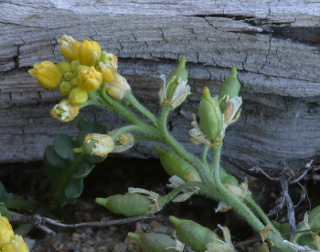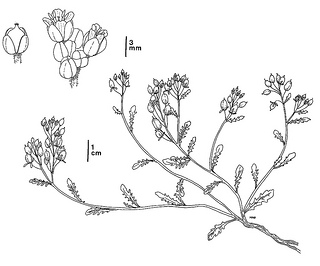(Rorippa subumbellata)
 Rorippa subumbellata. Photo © Steve Matson.
Rorippa subumbellata. Photo © Steve Matson.
 Rorippa subumbellata. CDFW illustration by Mary Ann Showers. (Click to enlarge)
Rorippa subumbellata. CDFW illustration by Mary Ann Showers. (Click to enlarge)
Tahoe yellow cress is a California endangered plant species, which means that killing or possessing this plant is prohibited by the California Endangered Species Act (CESA). Tahoe yellow cress is a dark green, low growing perennial herb that branches extensively. It blooms with yellow flowers between late May and early October, depending on precipitation and lake levels. At the time of this webpage's posting, Tahoe yellow cress is a candidate for listing under the federal Endangered Species Act(opens in new tab), and the California Natural Diversity Database reports 17 occurrences of Tahoe yellow cress that are presumed to still exist. In addition, Tahoe yellow cress has been declared by the Nevada Division of Forestry(opens in new tab) to be threatened with extinction, and it was added to the state list of fully protected species of native flora(opens in new tab) in 1983.
Tahoe yellow cress grows in the sandy beach habitat of Lake Tahoe's shores, mainly on the California side. Lake Tahoe has existed for over two million years with large fluctuations in lake levels, meaning that suitable habitat for Tahoe yellow cress changes often. Despite these variations, Tahoe yellow cress has survived because of its unique metapopulation dynamic in which a larger "mainland" population persists for long periods of time, while smaller "island" populations colonize and recolonize different habitats as the lake shore changes. Tahoe yellow cress is able to persist because it produces large rootstocks that spread rapidly and can lie dormant when its sandy habitat is threatened by erosion or rising lake levels, and because its seeds can be transported by water to nearby beaches allowing populations to re-sprout and colonize new and previously-suitable habitat.
Despite the unique adaptions of Tahoe yellow cress, it is endangered with extinction largely due to human impacts on occupied and potential habitat for the species. Tahoe yellow cress habitat has been impacted by altered lake level dynamics from the Truckee River Outlet Dam and Reservoir, the construction of public and private piers, docks, and other buildings, and the popular recreational use of the lake shore.
In 2002, a Conservation Strategy(opens in new tab) was published for Tahoe yellow cress, which was developed by Dr. Bruce Pavlik, Dr. Dennis Murphy, and a Technical Advisory Group consisting of thirteen state, federal, local and non-profit organizations, including CDFW. The Conservation Strategy outlined six conservation goals:
- Protect occupied habitat and potentially suitable habitat;
- Improve Tahoe yellow cress populations;
- Promote conditions that favor a positive metapopulation dynamic;
- Conduct research that directly supports management and restoration;
- Revise and continue the monitoring program for Tahoe yellow cress; and
- Implement an interagency adaptive management framework.
In 2005, an Adaptive Management Working Group (AMWG) began a series of translocation experiments. CDFW participated in an experimental outplanting and translocation study through the federal Cooperative Endangered Species Conservation Fund(opens in new tab), which resulted in a 2009 report titled Mitigation Options for Tahoe Yellow Cress (PDF)(opens in new tab). Many translocation experiments were inconclusive or unsuccessful, partially due to outside forces such as recreation and vandalism. Additional experiments are ongoing, but translocation has not yet been proven to be a viable mitigation option. It is important that the conservation goals identified in the Tahoe yellow cress Conservation Strategy continue to be implemented in order to conserve the species.
CDFW may issue permits for Tahoe yellow cress pursuant to CESA, and you can learn more about the California laws protecting Tahoe yellow cress and other California native plants. Populations of Tahoe yellow cress occur in CDFW's North Central Region. More information is also available from the U.S. Fish and Wildlife Service Species Profile for Tahoe yellow cress(opens in new tab).
Updated 06/20/2013